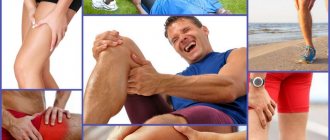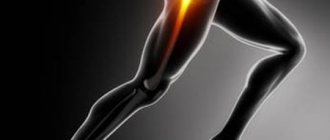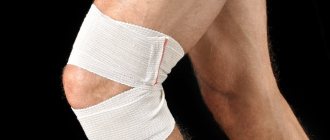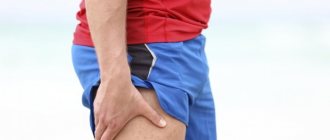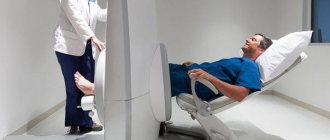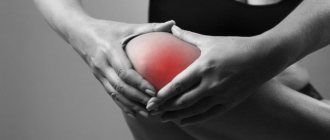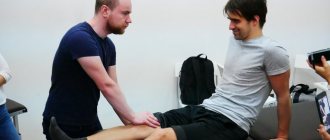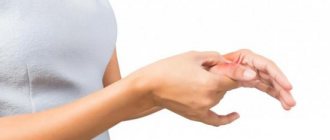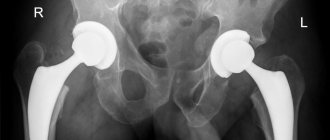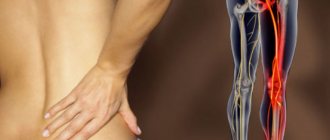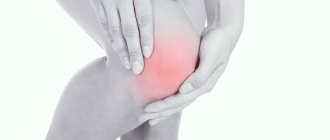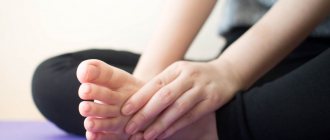The legs are exposed to stress every day, so everyone faces pain in this area, regardless of age. If moderate pain occurs periodically after physical exertion or hard work, then it is not dangerous. But when nagging pain in the leg from hip to foot becomes a constant companion, this indicates pathological changes.
There are many reasons for the appearance of pain: from damage to the spine, joints and muscles to vascular and metabolic pathologies. The clinical picture differs for different ailments. It is important to determine the cause of aching pain in the lower extremities and carry out treatment.
Spinal diseases
Osteochondrosis of the lumbosacral region is the most common cause of pain in the lower back and legs. This is due to the fact that this segment of the spine experiences the highest load.
With osteochondrosis, gradual destruction of intervertebral discs occurs. First, they become dehydrated, then microcracks appear on the surface, the nucleus pulposus inside is displaced, and the fibrous ring (outer membrane) ruptures. The disc is destroyed, after which the vertebrae themselves begin to wear out. Pathological changes lead to the patient's leg being pulled from the hip to the foot. When moving or exacerbating the process, the pain intensifies and becomes acute, it spreads along the back or side of the leg.
Reference. Osteochondrosis and aching pain in the lower limb are provoked by the following factors: poor posture, sedentary work, excessive physical activity, metabolic disorders, excessive weight, etc.
Other diseases of the spine that cause aching pain in the area of the leg from the hip to the foot:
- Protrusions (displacement of the nucleus pulposus without rupture of the outer membrane) and intervertebral hernias (prolapse of the nucleus after rupture of the fibrous ring) are complications of osteochondrosis. These formations can put pressure on the spinal cord and the nerve roots that come out of it.
- Spinal stenosis is a narrowing of the spinal canal that also damages the spinal nerves.
- Spondylosis is the growth of bone tissue along the edges of the vertebrae. This is another complication of osteochondrosis, in which the nerve roots are damaged by osteophytes (bone growths).
- Spondylolisthesis is a displacement of the bodies of adjacent vertebrae relative to each other. Then the spinal nerves damage the vertebrae.
- Cauda equina syndrome is a pinched nerve bundle that comes out of the lumbar and sacral region.
- Tumor growth in the spinal canal or in the lumbosacral segment.
The pathologies described above are accompanied by pain that spreads from the lower back to the thigh, lower leg and foot. The nature of the pain syndrome varies: from aching to acute. Discomfort increases after sudden movement, coughing or sneezing, or prolonged sitting.
In addition to pain, there are sensitivity disorders caused by pinched nerve roots. Then numbness, tingling, muscle weakness occurs, and sometimes the functionality of the pelvic organs is disrupted.
Damage to the sciatic nerve (one of the largest and longest nerves) causes sciatica. When it is pinched by a hernia or displaced vertebrae, pain occurs in the lower back, thigh, buttock, back of the leg to the foot.
It is important to treat spinal diseases in time to avoid consequences, for example, scoliosis or misalignment of the pelvic bones.
Using a pillow under the lower back for nagging pain
In the event that pain in the lower extremities has a nervous etiology, in order to get rid of unpleasant symptoms, it is necessary to ensure the correct anatomical position of the body. When a person remains motionless for a long time (for example, works in an office or at a store checkout for 8 hours or more), the spine is under constant tension, which can lead to pinched nerve roots. This dysfunction subsequently causes pain and discomfort. A lumbar pillow is the best option that will help you get rid of back and leg pain, and also prevent pinched nerve endings.
You can buy a lumbar pillow in the Medtechnika Orthosalon chain of stores in Ukraine. This is a specialized retail chain that provides high-quality orthopedic products, as well as medical equipment from leading companies in the world. Only here you will find certified products at an affordable price. Also in our stores for nagging pain are the following products:
- Needle applicators;
- Massagers;
- Orthopedic pillows;
- Waist belts, etc.
You can view the assortment in more detail in the catalog on the website ortosalon.ua. Select the category you need and view the list of products that interest you. If any difficulties arise, you can always contact the hotline, where our managers will answer all your questions.
Vascular pathologies
Aching pain in the lower extremities can cause vascular pathologies. Then discomfort occurs due to damage to the veins or arteries.
Varicose veins often provoke aching pain in the leg from the hip to the foot
Causes of nagging pain in the leg from the hip to the foot, which is caused by diseases of the blood vessels:
- Endarteritis is a chronic inflammatory lesion of the arteries of the legs, in which the walls of the vessel thicken, which over time leads to its complete blockage. Then symptoms of insufficient blood supply arise, due to which the leg tissues do not receive enough oxygen and nutrients. This leads to frequent cramps, aching pain, which causes intermittent claudication. After rest, the pain syndrome weakens, but if movement is necessary, it reappears. The causes of the disease are unknown, but doctors have found that it can be triggered by viral pathologies, allergies, long-term smoking, etc. Endarteritis quickly progresses, affecting new arteries. If left untreated, the risk of gangrene of the toes increases.
- Atherosclerosis of the blood vessels of the legs - deposition of cholesterol plaques and fats on the walls of blood vessels. This leads to thickening of the artery walls, increasing their fragility, narrowing of the lumen, and poor circulation. This leads to aching, dull, and sometimes burning pain that intensifies while walking. Atherosclerosis can be determined by constantly cold feet. The disease develops quickly and requires proper treatment.
- Thrombophlebitis of the legs - thickening of the vein walls, formation of blood clots. Swelling appears in the affected area, shooting and aching pain is felt in the depths and on the surface, and the temperature often rises. The pain reaction can be felt along the entire length of the limb, but it is especially pronounced in the calf area. Pathology threatens gangrene.
- Varicose veins are a violation of venous blood flow, in which the vessels dilate under the pressure of stagnant blood. During the pathological process, irritation of the nerve endings on the walls of the veins occurs, which leads to the pulling of the left or right leg from the hip to the foot. Externally, varicose veins are manifested by a vascular network, and in the later stages - by nodular dilations of veins under the skin.
- Lymphostasis is stagnation of fluid in the lymphatic vessels. This results in swelling and aching pain in one or both legs.
Most often, a pain reaction of a pulling nature in the lower limb occurs with varicose veins. This pathology can provoke thrombosis, thrombophlebitis, and the formation of trophic ulcers.
Using massagers to relax muscles
Massagers have shown excellent effectiveness in eliminating pain. The devices massage the skin, improving blood circulation. This reduces pain, improves intracellular metabolism, and eliminates discomfort in the body. Depending on the type of model, devices have different types of effects. For example, infrared devices generate infrared radiation, warming up the internal structures of the body, vibration devices affect the skin and muscles through vibrations, etc. More detailed information about the use of massagers will be provided to you by sales consultants of the Medtechnika Orthosalon network, as well as specially trained managers of our call center.
Using manual and electric massagers
The use of massage devices has a beneficial effect on the cells and tissues of our body. Manual and electric massagers at Medtekhnika Orthosalon provide the following effects:
- Warming up the skin and muscle structures;
- Stimulation of blood circulation and lymph flow;
- Elimination of fatigue, soreness, muscle pain and pain syndromes of nervous etiology;
- Prevention of nerve pinching;
- Improving the metabolism of internal tissues.
We invite you to personally familiarize yourself with the range of manual and electric massagers and visit one of the medical equipment stores in your city.
Applicator Lyapko
The analgesic effect of Lyapko applicators is carried out due to the point (acupuncture) effect on the nerve endings located on the surface of the skin. Needles made of noble metals stimulate nerve endings, as a result of which the functioning of the nervous system is normalized, pain and fatigue are eliminated, and the reflex mechanism is improved. The advantages of Lyapko applicators include the following:
- Effective massage effect;
- Quick relief of pain;
- Stimulation of nerve endings;
- Improvement of blood and lymph flow;
- Prevention of chronic diseases of the musculoskeletal and nervous system.
Lyapko applicators are one of the effective methods for eliminating pain syndromes. You can buy Lyapko applicators, massagers, orthopedic pillows for the lower back and many other useful products for your health in the Medtechnika Orthosalon chain of stores.
Muscle and tendon diseases
Nagging or aching pain in the leg from hip to heel can be caused by damage to muscles and ligaments. Then an inflammatory process occurs at the junction of the muscle with the tendon, in the area of the joint capsule, or in the area where the ligament connects to the bone. The affected area can be identified by the following symptoms: redness, swelling, pain.
Myalgia is muscle pain in the legs. This is not a disease, but a symptom that occurs as a result of physical activity, injuries, inflammatory, autoimmune diseases, prolonged depression, and sleep disorders. With myalgia, certain groups or all muscles of the body are affected (diffuse). When muscles are damaged in the area from the hip to the foot, aching pain, heaviness, swelling, and weakness occur.
Myositis is another cause of nagging, dull pain, the intensity of which increases with palpation or movement. This is an inflammatory disease in which 1–2 muscles are most often affected. The diffuse form is characterized by inflammation of different groups (including the muscles of the legs).
Patients complain that the leg hurts from the hip to the foot due to paratenonitis (inflammation of the tendons), myoenthesitis (inflammation of the area where the tendon passes into the muscle), tendinitis (inflammation of the synovial sheath of the tendon), fasciitis (inflammation of the connective tissue sheaths of the muscles). Tendons are damaged by excessive physical stress on the leg muscles. The risk of inflammation increases with a weakened body, hypothermia, the presence of chronic pathologies, etc. Then pain and swelling occur in the affected area.
Diseases of joints and bones
Chronic arthritis of the leg joints affects not only the bone joints, but also the surrounding soft tissues. Often with the disease, the inflammatory process spreads to both limbs. Then an aching or sharp pain occurs, which intensifies during the load on the legs. The clinical picture is complemented by edema, local fever, joint deformation, limited mobility, and the appearance of rheumatic nodules.
Polyarthrosis is a dystrophic lesion of the cartilage tissue of the joints. This disease primarily affects the bony joints of the legs. In the initial stages, the aching pain that spreads from the thigh to the lower leg and foot is not particularly worrying. But as the pathology progresses, the pain syndrome intensifies and is disturbing even at rest.
Causes of pain in the femoral muscle
Sometimes, after a broken leg, osteomyelitis develops - a purulent infection in the bones and all its elements. The pathology is manifested by a sharp increase in temperature, intoxication of the body and acute pain. When it becomes chronic, pain of a pulling nature appears along the entire length of the limb.
Soreness after a broken leg may occur during rehabilitation or several years after the injury. Discomfort may occur while walking due to the bone not healing properly.
Flat feet (flattening of the arch of the foot) leads to weakening of the ligaments and muscles. Then the lower limbs get tired faster even during minor loads. This leads to heaviness, aching pain and swelling.
Osteoporosis is characterized by a decrease in bone mass and an increase in its fragility. In the diffuse form of the pathology, all bones are affected, but it is especially dangerous for the femurs (femoral neck). Then even a minor blow or fall from a height can cause a fracture. Osteoporosis manifests itself as aching pain in all bones, including the area from the hip to the foot.
Metabolic diseases
One of the causes of aching pain in the legs at night is gout. With this pathology, purine metabolism is disrupted, and uric acid salts accumulate in the joints. This leads to joint pain.
Gout most often affects the big toe, but can spread to all joints of the lower extremities
Most often, the big toe is affected first, but gradually the pathological process spreads to other bone joints. The attack begins at night, then the skin on the affected area turns red, the local temperature rises, and aching pain appears, which in advanced cases can spread from the big toe to the thigh. In severe cases of gout, the overall body temperature rises.
Attacks last from several days to several weeks. Then the pain disappears and the functionality of the affected joints is restored. The disease worsens from 2 to 6 times per year.
Reference. An attack of gout, which causes aching pain, can occur after drinking alcohol, tonic drinks (coffee, strong tea, cocoa), and fatty meat.
A specific symptom of gout is tophi (gouty nodes). These are compactions in the subcutaneous tissue that consist of deposits of uric acid crystals. They are localized over the affected bone joints. Their favorite places are the Achilles tendon, ankle and hip flexors.
Diabetes mellitus often causes complications in the legs, especially in patients over 45 years of age. This occurs due to vascular atherosclerosis and insufficient blood supply. Painful pulling sensations occur while walking or at rest.
You can understand that pain in the lower extremities is caused by diabetes mellitus by the following signs:
- drying, peeling of the skin, itching;
- the appearance of pigment spots;
- in men, the hairs on the calves turn gray and fall out;
- the skin of the legs is pale and cool or warm but bluish.
To stop pathological changes in blood vessels, as well as get rid of excruciating pain, you need to consult a phlebologist.
Other reasons
Oncological pathologies can also cause aching pain along the entire length of the lower limb. Malignant bone tumors destroy normal tissue, causing pathological fractures and nagging pain. It is quite difficult to identify a neoplasm at the initial stage, since patients often do not pay attention to the symptoms.
Cancer of the nerve vessels of the legs causes severe pain and limited mobility. At rest, the pain syndrome becomes aching in nature.
Less dangerous reasons include:
- Excessive physical stress. With regular high load on the legs, for example, during frequent squats, the muscles are overloaded and spasm occurs. Then the person’s legs are pulled from the hip to the foot.
- Sedentary work. When sitting for a long time, blood stagnation occurs in the veins of the lower extremities. The muscles feel a lack of nutrients and lactic acid accumulates in them. As a result, dull, aching or stabbing pain occurs. Often this symptom is accompanied by cramps and heaviness.
- Convulsive contractions of the leg muscles. Involuntary muscle spasms can occur as a result of metabolic disorders, blood circulation, or excessive physical activity. The spasm is accompanied by sharp and aching pain. Discomfort may occur in a specific muscle or in an area from the hip to the foot. The pathological process is indicated by convulsions that occur regularly.
- Violation of water-salt balance. With a lack of salts in the body, muscle pain appears. A similar condition can occur during diarrhea, vomiting or taking diuretics. Dehydration is manifested by severe thirst, edema, hypotension, tachycardia (increased heart rate). In addition, there is a nagging pain in the leg muscles.
- Excessive weight. Overweight people often complain of soreness in their legs, especially after walking for a long time. This is caused by the fact that the joints and muscles of the lower extremities are subject to great stress.
Reference. Pregnant women also often complain of aching pain in their legs from the hip to the foot. The cause of discomfort may be a violation of mineral metabolism, weight gain, pinched nerves in the lumbar spine, etc.
How can an orthopedic seat cushion help?
If pain of nervous etiology occurs, doctors recommend using an orthopedic pillow under the lower back. What is its effect? First of all, this is:
- Correct anatomical support of the spinal column and lumbar region;
- Relieving stress and tension from the spine;
- Supporting correct posture;
- Establishing blood circulation;
- Relieves general fatigue throughout the day.
Medtekhnika Orthosalon offers a variety of pillow models that effectively eliminate nagging pain in the lower back and legs. We cooperate only with trusted brands, of which we are 100% confident.
When to see a doctor
If aching pain occurs rarely, for example, after physical activity, and goes away quickly, then there is no need to worry. But there are several signs that indicate the development of pathological processes in the body:
- painful sensations in the lower extremities from the hip to the feet occur regularly;
- swelling appeared;
- the pain increases;
- vascular networks or swollen veins appeared on the legs;
- the area from the thigh to the foot turned red, the local and general temperature increased;
- the lower limb was swollen, the skin became pale and cool.
If at least one of the above symptoms appears, you should schedule a visit to your physician or surgeon. It is important to find out the cause of the pathological process.
Diagnostics
The examination begins with a thorough medical history. Then the doctor conducts a visual examination, assesses muscle strength and leg reflexes using special tests.
Electromyography of the lower extremities
To clarify the diagnosis, additional instrumental studies are prescribed:
- X-ray allows you to evaluate the structure of the lumbar spine and leg joints.
- CT is performed to detect bone tissue pathologies in the early stages.
- MRI shows the condition of the soft tissues (intervertebral discs, muscles, ligaments, tendons, spinal cord, nerve roots, blood vessels) that surround the bones.
- Electromyography is prescribed to assess the condition of muscle fibers and their innervation.
To identify inflammatory processes, blood tests (clinical and biochemical) are prescribed. In some cases, a biopsy is performed (sampling of tissue fragments from the affected area), which makes it possible to accurately determine the nature of the disease.
Treatment methods
It is strictly forbidden to treat diseases that cause aching pain from the hip to the foot on your own. Such therapy, at best, will not give a positive effect, and at worst, it will aggravate the patient’s condition. It is important to identify the cause of discomfort, establish the severity of the pathology and draw up a treatment program taking into account the patient’s age and the characteristics of his body. In some cases, conservative treatment is sufficient, while in others, urgent surgical intervention is necessary.
In the event of the initial occurrence of moderate pain syndrome, you can proceed according to the following plan:
- Give your legs a rest. It is recommended to lie down and raise your limbs to a slight elevation (slightly above heart level). This will restore venous blood flow, stop the increase in swelling, and relax the muscles.
- Use a cold compress. Apply an ice pack or heating pad to the affected area for 10 to 15 minutes. After some time, the procedure can be repeated.
- Take a pain reliever. To relieve pain and inflammation, it is necessary to use drugs from the NSAID group, for example, Ibuprofen, Naproxen.
If the pain is caused by physical activity or a cramp, you can massage the limb.
After this, you should visit a doctor as soon as possible.
Often aching pain is caused by diseases of the musculoskeletal system; the following drugs are used to treat them:
- Chondroprotectors, for example, Teraflex, Artra, Dona. These drugs stop the destruction of cartilage, nourish bone tissue, and start regeneration processes.
- Muscle relaxants: Bklofen, Mydocalm, Structum, Tizalud. Relaxes spasming muscles, improves blood supply, tissue trophism, and relieves pain.
- Vasodilators: Flexital, Pentoxifylline. They expand the lumen of blood vessels, normalize blood supply and tissue nutrition.
- External agents (ointments, creams, gels): Finalgon, Dolgit, Voltaren. Reduce pain and inflammation.
- Preparations based on calcium, vitamin D, phosphorus: Osteogenon, Kalcemin, Calcium-D3 Nycomed. Saturates the body with calcium, increases bone strength. Used for osteoporosis.
If tumors are present, the doctor prescribes cytotoxic drugs for chemotherapy. These include Fluorouracil, Cyclophosan.
For osteomyelitis, antibiotics are indicated, for example, Oxacillin, Cefazolin, Vancomycin. Antibacterial agents are used to prevent infection in open fractures, as well as to treat bone tuberculosis, arthritis, etc.
For the treatment of varicose veins in the initial stages, the following drugs are prescribed:
- Phlebotonics: Phlebaven, Phlebodios, Aescusan, Rutoside.
- Anticoagulants: Heparin, Aspirin, Cardiomagnyl.
- Antiplatelet agents: Curantil, Trental, Pentoxifylline.
For external use, products are used in the form of creams and gels, for example, Lyoton, Venolife.
The diet will allow you to lose extra pounds, maintain normal weight, replenish the body with useful substances, and normalize metabolic processes. Proper nutrition involves avoiding fatty, fried, too spicy foods, canned, smoked, confectionery and products, as well as other products that contain many chemical additives. It is important to replenish your diet with vegetables, fruits, berries, herbs, whole grains, lean meat, fish, nuts, etc. Your doctor will advise you in more detail about your diet.
Exercise therapy is an obligatory component of complex therapy
Therapeutic exercise allows you to strengthen muscles, activate metabolic processes, and reduce the load on the vertebrae and joints. The complex is compiled by a doctor individually for each patient. In addition, it is recommended to walk more, ride a bike, swim, etc.
The list of therapeutic measures is supplemented by massage, physiotherapeutic procedures, alternative methods, for example, reflexology, hirudotherapy, etc.
Diseases that provoke aching pain in the leg from hip to foot need to be treated comprehensively. Only then will it be possible to achieve positive dynamics and speed up recovery.
Surgical treatment methods are used as a last resort:
- Lack of therapeutic effect after long-term use of conservative treatment methods.
- Severe pain that is not relieved by strong medications.
- Impaired functionality of the pelvic organs due to pinched nerve fibers in the lumbosacral spine.
Most often, surgery is prescribed for diseases of the spine, for example, intervertebral hernia or spondylolisthesis. In advanced cases of varicose veins, phlebectomy (vein removal) is performed. Surgery is also necessary for thrombosis.
How to get rid of hip pain at home?
Treatment of pain in the thigh from the buttock to the knee will depend directly on the cause that provoked such a picture. If pain in the hip appears due to an injury or bruise, it is imperative to buy a bandage that will help fix the damaged area and relieve excessive tension from it. Often, nagging pain occurs against the background of osteochondrosis. In this case, you will need to buy a lower back brace. Since this area concentrates the bulk of the body weight during exercise, it is very important to prevent its overload. This will also help prevent pinched nerves and help relieve fatigue.
If you were injured the day before, you will need to use a cold compress, but if the cause of the pain in your hip is a chronic disease or a simple muscle strain, you need to take a warm bath to relax the muscle fibers, this way you will get rid of soreness. For the first time after the onset of unpleasant symptoms, try to limit yourself from physical activity and try to get more rest. Ideally, you need to stick to bed rest for a couple of days so that the muscles and damaged ligaments have time to renew. It is best to contact a traumatologist or rehabilitation specialist, who will conduct a diagnosis and, possibly, prescribe a set of physiotherapeutic procedures, as well as anti-inflammatory and painkillers.
Lumbar bandage for hip pain
When pain in the hip appears due to a pinched nerve or any other disorder in the central nervous system, it is very important to protect your musculoskeletal system and relieve it as much as possible. A lower back bandage will relieve tension in this area and help prevent damage to nerve endings. If you suffer from osteochondrosis, arthritis, arthrosis or any other diseases of the musculoskeletal system, you definitely need to buy a lumbar belt. This is a high-quality prevention of relapses of chronic diseases and an excellent way to get rid of pain in the back and lower extremities in the shortest possible time.
The most important
Most often, nagging pain in the leg from the hip to the foot occurs when the spinal nerves, which are located in the lumbosacral segment, are pinched. Also, discomfort in one or both limbs often provokes varicose veins. To avoid dangerous consequences, you need to consult a doctor if painful sensations appear, especially if they occur regularly, are accompanied by swelling, changes in body temperature, the appearance of venous nodes, etc. If the pain occurs rarely and goes away quickly, then there is no need to worry. Treatment of pathologies that provoke nagging pain is carried out only after a thorough diagnosis and determination of the cause. Therapy should be comprehensive: medication, exercise therapy, diet, physiotherapy, massage, etc.
Pain in the back of the thigh
Nagging pain in the back of the thigh can be triggered by high physical activity, during which muscle fibers or ligaments were damaged. Athletes' muscles are more vulnerable to damage after insufficient stretching, so it is very important to properly warm up the body before training. Also, the cause of pain from the gluteal muscle to the knee may be a violation of the sciatic nerve. Such pain is especially pronounced when bending, flexing and extending the hip or knee joints. Acute pain can be caused by improper, sudden lifting of weights, so if you have to lift weights, be sure to use a lower back brace, this way you can prevent back damage and damage to muscles and nerves. You can find these in one of our medical equipment stores in Odessa, Zaporozhye, Dnieper, Kyiv, Lviv and other cities of Ukraine, or order them in the online store ortosalon.ua.
If you are bruised and your leg hurts from the buttock to the knee, you need to apply a cold compress to your leg and fix the damaged area with a thigh bandage. If the pain does not go away after two weeks or more, it is recommended to consult a doctor. Even an experienced doctor will not dare to make a reliable diagnosis based on hip pain without additional diagnostics, since the causes of such discomfort can be very different and they can affect various components of the musculoskeletal system, namely:
- Upper and inner epithelial layer;
- Ligaments;
- Tendons;
- Muscles and fascia;
- Nerve roots of the spine.
Causes of hip pain from buttock to knee
In order to at least roughly understand what caused the pain in the hip, you need to find out what biological structure of your musculoskeletal system was damaged, namely:
- Bone. Often such pathological conditions of the body as osteochondrosis, osteoporosis, arthrosis, bursitis become the cause of hip pain. Pain syndrome can also be a consequence of a bruise. In this case, a hematoma also becomes a companion to discomfort in the leg;
- Muscles and tendons. Hip pain can occur due to a rupture, sprain, or any other type of soft tissue injury;
- Infectious and non-infectious etiology. Pain in the leg can be caused by the presence of inflammatory processes of an infectious and non-infectious nature. The most serious causes of leg pain include bone tuberculosis. You must understand that a seemingly insignificant symptom can become a serious signal of a dangerous disease, so if you experience the slightest discomfort, you should seek advice from an experienced traumatologist or orthopedist;
It often happens that patients turn to doctors when the disease has already begun the active stage of destructive work. People expect some kind of “miracle” from specialists when fighting the disease becomes more and more difficult. The first thing I would like to wish for every patient is: firstly, of course, not to get sick, and secondly, if you feel that something is “wrong” with your health, please consult a doctor in a timely manner. This will save your time, money and, most importantly, your own health - Igor Pavlovich Bondarenko, head of the traumatology department of DOKOL.
The cause of pain in the leg from the knee to the gluteal muscle can also be:
| Various neoplasms | This includes oncological formations of a malignant and benign nature |
| Joint disorders | Pain can be caused by joint diseases, such as arthritis or arthrosis, during which the arterial lumen narrows, which directly leads to pain. |
| Central nervous system disorders | The central nervous system instantly reacts to any problems in the functioning of our body, and therefore instantly sends a signal to the brain so that we take measures to eliminate the problem. Perhaps your hip pain was caused by a pinched nerve, neuritis, or any other disorder related to the central nervous system. |
| Other reasons | There are also a number of secondary reasons that can cause nagging pain from the buttock to the knee. This may be weakened muscle tone, the body’s metrological reaction to changes in weather or climate, pregnancy, a recurrent period of old injuries or bruises |
Drawing pain in thigh. Additional symptoms
The following symptoms will help you most accurately diagnose hip pain:
- Swelling;
- Feeling of “stiffness” in joints (knee or hip);
- Fever/chills;
- Changes in the outer skin (spots, hematomas);
- Local deformation of the thigh surface (usually small bumps can be seen on the damaged area).
If, along with hip pain, you encounter one of the above symptoms, this indicates that some pathological processes are occurring in your body, which means you need to consult a doctor as soon as possible.
